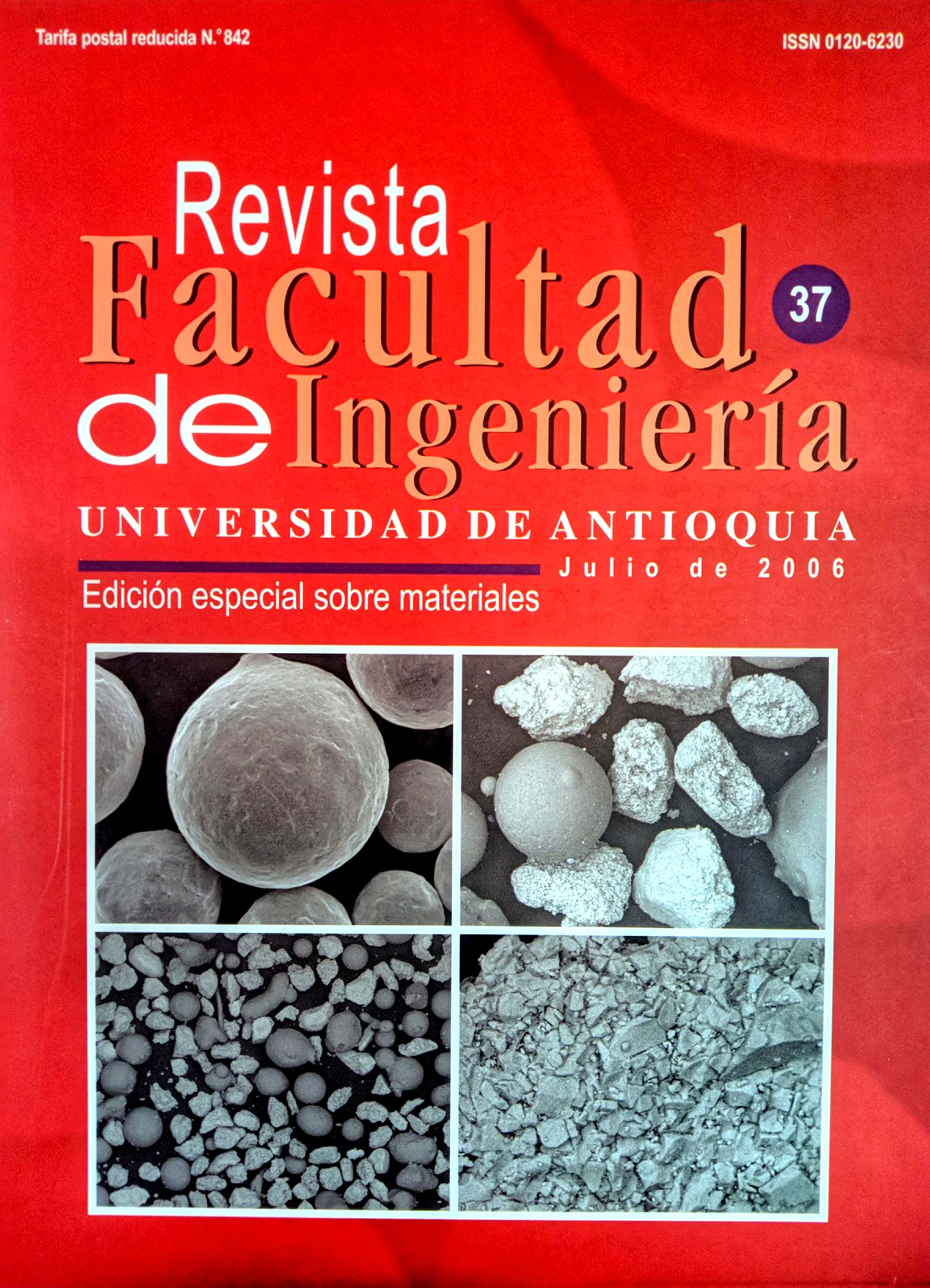Bioactive coatings deposited by sol-gel on titanium alloys
DOI:
https://doi.org/10.17533/udea.redin.343454Keywords:
titanium alloys, sol-gel, bioactive coatings, electrochemical assaysAbstract
Biomedical prosthetic devices are developed to be used in the human body in an effort to substitute the function provided by the original part. Metallic materials are used in the human body mainly for orthopedical purposes and their degradation by wear and or corrosion should be negligible. However, metals display some problems such as the in situ degradation and the requirement of external fixation. One of the ways of minimizing the release of corrosion products from the implant to the surrounding tissue consists in applying a protective coating. This protective coating may be functionalized with a bioactive material, able to generate a natural bonding to the living tissue. This work describes the development of a double layer coating obtained by the sol-gel technique containing bioactive glass, glass-ceramic and hydroxyapatite particles in hybrid methyl-triethoxisilane (MTES) and tetraethilorthosilicate (TEOS) acidic sol. The layer is applied on titanium alloy (ASTM F 67) by the dip-coating method. The electrochemical behavior of the coated samples was evaluated by potentiodynamic polarization curves and electrochemical impedance spectroscopy assays (EIS) using simulated body fluid (SBF) as electrolyte.
Downloads
References
D. Rodríguez. “Obtención de capas de nitruro de titanio mediante tratamiento termoquímico en titanio y Ti6Al4V y caracterización de sus propiedades para aplicaciones biomédicas”. Departamento de Ciencias de los Materiales e Ingeniería Metalúrgica. Universidad Politécnica de Cataluña, Barcelona. 1999. pp. 142.
A. W. E. Hodgson, Y. Mueller, D. Forster, S. Virtanen. “Electrochemical characterization of passive films on Ti alloys under simulated biological conditions”. Electrochimia Acta. Vol. 47. 2002. pp. 1913-1923. DOI: https://doi.org/10.1016/S0013-4686(02)00029-4
D. Zaffe, C. Bertoldi, U. Consolo. “Element release from titanium devices used in oral and maxillofacial surgery”. Biomaterials. Vol. 24. 2003. pp. 1093-1099. DOI: https://doi.org/10.1016/S0142-9612(02)00424-6
T. Yue, Z. Mei, H. C. Man. “Excimer laser surface treatment of Ti-6Al-4V alloy for corrosion resistance enhancement”. Materials Letters. Vol. 52. 2002. pp. 206-212. DOI: https://doi.org/10.1016/S0167-577X(01)00395-0
B. Finet, G. Weber, R. Cloots. “Titanium release from dental implants: an in vivo study on sheep”. Materials Letters. Vol. 43. 2000. pp. 159-165. DOI: https://doi.org/10.1016/S0167-577X(99)00251-7
M. Long, H. J. Rack. “Titanium alloys in total joint replacement- a materials science perspective”. Biomaterials. Vol. 19. 1998. pp. 1621-1639. DOI: https://doi.org/10.1016/S0142-9612(97)00146-4
I. Milosev, M. Metikos-Hukovic, H. H. Strehblow. “Passive film on orthopedic TiAlV alloy formed in phusiological solution investigated by X-Ray photoelectron spectroscopy”. Biomaterials. Vol. 21. 2000. pp. 2103-2113. DOI: https://doi.org/10.1016/S0142-9612(00)00145-9
K. Wang. “The use of titanium for medical applications in the USA”. Materials Science and Engineering. Vol. A213. 1996. pp. 134-137. DOI: https://doi.org/10.1016/0921-5093(96)10243-4
A. Scribner. Z plot for windows, Electrochemical Impedance Software Operating Manual. Part I, I. Scribner Associates, Editor. 1998: Southern Pines, NC.
C. Ohtsuki, T. Kokubo, T. Yamamuro. “Mechanism of apatite formation on CaO-SiO2-P2O5 glasses in a simulated body fluid”. Journal of Non Crystalline solids. Vol. 143. 1992. pp. 84-92. DOI: https://doi.org/10.1016/S0022-3093(05)80556-3
T. Kokubo, H. Kushitani, C. Ohtsuki, S. Sakka, T. Yamamuro. “Chemical reaction of bioactive glass and glass ceramics with a simulated body fluid”. Journal of Materials science: Materials in medicine. Vol. 3. 1992. pp. 79-81. DOI: https://doi.org/10.1007/BF00705272
T. Kasuga, K. Nakagama, M. Yoshida, E. Miyade. “Compositional dependence of formation of an apatite layer on glass-ceramics in simulated phusiological solution”. Journal of Materials Science. Vol. 22. 1987. pp. 3721-3724. DOI: https://doi.org/10.1007/BF01161484
C. García, A. Durán, S. Cere. “Recubrimientos bioactivos realizados por sol-gel sobre acero inoxidable 316L”. II Congreso Internacional de Materiales - VII Congreso Nacional de Corrosión y Protección. Bucaramanga, Colombia, 2003. pp. 36-42.
M. Metikos-Hukovic, I. Milosev, H.H Strehblow. “An in vitro study of Ti and Ti-alloys coated with sol-gel derived hydroxyapatite coatings”. Surface and Coatings Technology. Vol. 165. 2003. pp. 40-50. DOI: https://doi.org/10.1016/S0257-8972(02)00732-6
C. Liu, Q. Bi, A. Leyland, A. Matthews. “An electrochemical impedance spectroscopy study of the corrosion behaviour of PVD coated steels in 0.5N NaCL aqueous solution: Part II. EIS interpretation of corrosion behaviour”. Corrosion Science. Vol. 45. 2003. pp. 1257-1273. DOI: https://doi.org/10.1016/S0010-938X(02)00214-7
A. Durán, A. Conde, A. Gómez Coedo, T. Dorado, C. García, S. Ceré. “Sol-gel coatings for protection and bioactivation of metals used in orthopedic devices”. Journal of Materials chemistry. Vol. 14. 2004. pp. 2282-229 DOI: https://doi.org/10.1039/B401370K
Downloads
Published
How to Cite
Issue
Section
License
Revista Facultad de Ingeniería, Universidad de Antioquia is licensed under the Creative Commons Attribution BY-NC-SA 4.0 license. https://creativecommons.org/licenses/by-nc-sa/4.0/deed.en
You are free to:
Share — copy and redistribute the material in any medium or format
Adapt — remix, transform, and build upon the material
Under the following terms:
Attribution — You must give appropriate credit, provide a link to the license, and indicate if changes were made. You may do so in any reasonable manner, but not in any way that suggests the licensor endorses you or your use.
NonCommercial — You may not use the material for commercial purposes.
ShareAlike — If you remix, transform, or build upon the material, you must distribute your contributions under the same license as the original.
The material published in the journal can be distributed, copied and exhibited by third parties if the respective credits are given to the journal. No commercial benefit can be obtained and derivative works must be under the same license terms as the original work.










 Twitter
Twitter